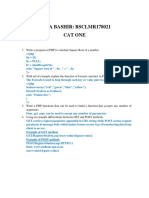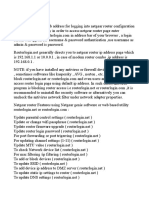0 ratings0% found this document useful (0 votes)
33 viewsLesson 10 PHP-Connection With Database
This document discusses connecting PHP to databases. It covers HTML form requests using GET and POST methods. It then demonstrates creating a login form with validation in PHP and MySQL. It shows how to create a registration form, store the data in a database table, and fetch the stored data. The key steps are creating databases and tables in PHPMyAdmin, building HTML forms, and using PHP to connect to the database and execute SQL queries to insert, select, and display data.
Uploaded by
1045858Copyright
© © All Rights Reserved
Available Formats
Download as PDF, TXT or read online on Scribd
0 ratings0% found this document useful (0 votes)
33 viewsLesson 10 PHP-Connection With Database
This document discusses connecting PHP to databases. It covers HTML form requests using GET and POST methods. It then demonstrates creating a login form with validation in PHP and MySQL. It shows how to create a registration form, store the data in a database table, and fetch the stored data. The key steps are creating databases and tables in PHPMyAdmin, building HTML forms, and using PHP to connect to the database and execute SQL queries to insert, select, and display data.
Uploaded by
1045858Copyright
© © All Rights Reserved
Available Formats
Download as PDF, TXT or read online on Scribd
You are on page 1/ 9
Web Design and Development Lesson 10
Lesson 10: PHP –Connecting with Database
Lesson 10: PHP –Connecting with Database ................................................................................. 1
10.1 HTML FORM Requests ..................................................................................................... 2
10.1.1. GET Method .............................................................................................................. 2
10.1.2. POST Method ............................................................................................................ 3
10.2 Login Form with Validation in PHP and MYSQL ............................................................. 3
10.3 PHP FORM Registration using SQL .................................................................................. 5
10.3.1. Creating Database ..................................................................................................... 5
10.3.2. Creating Registration Form ....................................................................................... 6
10.3.3. Storing data in the database ..................................................................................... 7
10.3.4. Fetching data from the database.............................................................................. 8
Lesson 10 Revision Question ...................................................................................................... 9
Compiled by: Karari E.K email: cats.mwalimu@gmail.com 1
Web Design and Development Lesson 10
10.1 HTML FORM Requests
The most used HTTP request types are GET and POST, but there are other types in their
technical specification, such as PUT, HEAD, DELETE, PATCH and OPTIONS. We will
focus only on the two most common.
• The GET Method
• The POST Method
Before the browser sends the information, it encodes it using a scheme called URL
encoding. In this scheme, name/value pairs are joined with equal signs and different
pairs are separated by the ampersand.
name1=value1&name2=value2&name3=value3
Spaces are removed and replaced with the + character and any other nonalphanumeric
characters are replaced with a hexadecimal value. After the information is encoded it is
sent to the server.
10.1.1. GET Method
The GET method sends the encoded user information appended to the page request. The page
and the encoded information are separated by the ? character.
http://www.test.com/index.htm?name1=value1&name2=value2
The GET method produces a long string that appears in your server logs, in the browser's
Location: box.
• The GET method is restricted to send up to 1024 (8 KB, or 8192 bytes ) characters only. in URI
• Never use GET method if you have password or other sensitive information to be sent to the
server.
• GET can't be used to send binary data, like images or word documents, to the server.
• The data sent by GET method can be accessed using QUERY_STRING environment variable.
• The PHP provides $_GET associative array to access all the sent information using GET
method.
Compiled by: Karari E.K email: cats.mwalimu@gmail.com 2
Web Design and Development Lesson 10
10.1.2. POST Method
The POST method transfers information via HTTP headers. The information is encoded as
described in case of GET method and put into a header called QUERY_STRING.
• The POST method does not have any restriction on data size to be sent.
• The POST method can be used to send ASCII as well as binary data.
• The data sent by POST method goes through HTTP header so security depends on HTTP
protocol. By using Secure HTTP (https) you can make sure that your information is secure.
• The PHP provides $_POST associative array to access all the sent information using GET
method.
10.2 Login Form with Validation in PHP and MYSQL
Step 1: create database using XAMPP PHP admin. Enter database name as login then click
create button.
Step 2. Create table called user.
Step 3 Create table fields.
Create path >Xampp>htdocs> login folder.
Next step save all table fields inside login folder > open Notepad++ >save as login.php inside
login folder.
Compiled by: Karari E.K email: cats.mwalimu@gmail.com 3
Web Design and Development Lesson 10
login.php file
Process.php file
Compiled by: Karari E.K email: cats.mwalimu@gmail.com 4
Web Design and Development Lesson 10
Successful login
10.3 PHP FORM Registration using SQL
10.3.1. Creating Database
Step 1: Create the database to use. command – create database school;
Step 2: Select the database to use. command – use school;
Step 3: Create a table named students-
Compiled by: Karari E.K email: cats.mwalimu@gmail.com 5
Web Design and Development Lesson 10
10.3.2. Creating Registration Form
Here, we will create a form and store the data collected from it in our school database.
We will Create two files, index.php and connect.php.
The file index.php will carry the form HTML code, while connect.php connects the
form with the database.
Compiled by: Karari E.K email: cats.mwalimu@gmail.com 6
Web Design and Development Lesson 10
10.3.3. Storing data in the database
➢ Open index.php >fill in the registration form
➢ After filling the form >click login then if results are successful Record saved
When we open http://localhost/phpmyadmin/ on the browser we should have something like
this in our database.
Compiled by: Karari E.K email: cats.mwalimu@gmail.com 7
Web Design and Development Lesson 10
10.3.4. Fetching data from the database
To fetch the data that we just saved, add the code below into index.php right under the
</form> tag.
Compiled by: Karari E.K email: cats.mwalimu@gmail.com 8
Web Design and Development Lesson 10
On refreshing the page, we should see (The data at the bottom of the page has been fetched
from the database):
Lesson 10 Revision Question
a) Write a PHP code to connect a database named Registration in a XAMPP database
server.
Compiled by: Karari E.K email: cats.mwalimu@gmail.com 9
You might also like
- IT 423 Project One Database Interface InstructionsNo ratings yetIT 423 Project One Database Interface Instructions19 pages
- Course Outline Web Design and DevelopmentNo ratings yetCourse Outline Web Design and Development2 pages
- ITC-226 Web Systems & Tech: PHP and MysqlNo ratings yetITC-226 Web Systems & Tech: PHP and Mysql29 pages
- SA3 - UI, Session, Cookies, DB Connection and Reset Password Feature(1)No ratings yetSA3 - UI, Session, Cookies, DB Connection and Reset Password Feature(1)20 pages
- PHP in Web Environment - Exercises: 1. Login PageNo ratings yetPHP in Web Environment - Exercises: 1. Login Page9 pages
- Name - Mihir Humar REG NO. - 18BCE0828 Internet and Web Programming Lab Exercise 9No ratings yetName - Mihir Humar REG NO. - 18BCE0828 Internet and Web Programming Lab Exercise 96 pages
- Curriculum: What You Will Be Able To Achieve During This CourseNo ratings yetCurriculum: What You Will Be Able To Achieve During This Course5 pages
- PHP The Ultimate Step by Step Guide For Beginners100% (1)PHP The Ultimate Step by Step Guide For Beginners182 pages
- Write A PHP Program To Exchange The First and Last Characters in A Given String and Return The New StringNo ratings yetWrite A PHP Program To Exchange The First and Last Characters in A Given String and Return The New String34 pages
- Create An HTML Form and Insert Data Into The Database Using PHPNo ratings yetCreate An HTML Form and Insert Data Into The Database Using PHP15 pages
- Web Development Training Syllabus: 1. Core PHP+MYSQL (Level - 1)No ratings yetWeb Development Training Syllabus: 1. Core PHP+MYSQL (Level - 1)3 pages
- php assignment_05cec210-23f3-4b32-be57-a93310b93cb2No ratings yetphp assignment_05cec210-23f3-4b32-be57-a93310b93cb226 pages
- (2) Phạm Hữu Khang, Xây Dựng Ứng Dụng Web Bằng PHP & MySQL Tập 2 (2007) - NXB Phương ĐôngNo ratings yet(2) Phạm Hữu Khang, Xây Dựng Ứng Dụng Web Bằng PHP & MySQL Tập 2 (2007) - NXB Phương Đông6 pages
- DW Lesson 8 Web Development Tools - FINALNo ratings yetDW Lesson 8 Web Development Tools - FINAL43 pages
- DW Lesson 8 Web Development Tools - FINALNo ratings yetDW Lesson 8 Web Development Tools - FINAL43 pages
- Core PHP (Duration 20-22 Classes) Topics: PHP, Mysql, Javascript0% (1)Core PHP (Duration 20-22 Classes) Topics: PHP, Mysql, Javascript6 pages
- PHP Oracle Web Development: Data processing, Security, Caching, XML, Web Services, and AjaxFrom EverandPHP Oracle Web Development: Data processing, Security, Caching, XML, Web Services, and AjaxNo ratings yet
- Lynda - PHP With MySQL Essential Training 2013 - Tutorial - Video Learning - Lynda - Total Training - Video2Brain - Tutsplus - Kelby - LiveLesson - WileyNo ratings yetLynda - PHP With MySQL Essential Training 2013 - Tutorial - Video Learning - Lynda - Total Training - Video2Brain - Tutsplus - Kelby - LiveLesson - Wiley4 pages
- PHP Workshop 29 Jun - 2 Jul 2010 - PHP & MysqlNo ratings yetPHP Workshop 29 Jun - 2 Jul 2010 - PHP & Mysql36 pages
- Prototype Phase and Final Viva QuestionsNo ratings yetPrototype Phase and Final Viva Questions10 pages
- Login and Registration System: Create A Database in Your Server Named Login - System' and Then Insert Table Named Users'No ratings yetLogin and Registration System: Create A Database in Your Server Named Login - System' and Then Insert Table Named Users'4 pages
- Module 2 - Software Development Life Cycle ModelsNo ratings yetModule 2 - Software Development Life Cycle Models80 pages
- Web Technology Important Questions 2 Marks and 16 Marks100% (2)Web Technology Important Questions 2 Marks and 16 Marks5 pages
- UPGRADING THE TRANZEO TR-CPE200 Build 77No ratings yetUPGRADING THE TRANZEO TR-CPE200 Build 773 pages
- Nagarjuna College of Information Technology Tribhuvan University Institute of Science and TechnologyNo ratings yetNagarjuna College of Information Technology Tribhuvan University Institute of Science and Technology27 pages
- Personal Expenses Management System (PEMS)100% (1)Personal Expenses Management System (PEMS)12 pages
- Heli Pack Science and Technology (Qingzhou) Co.,Ltd See Full Import - Export History ImportGenius3No ratings yetHeli Pack Science and Technology (Qingzhou) Co.,Ltd See Full Import - Export History ImportGenius36 pages
- Cyberspace and The Information SuperhighwayNo ratings yetCyberspace and The Information Superhighway7 pages
- توصيل المقاومات على التوالي والتوازي PDFNo ratings yetتوصيل المقاومات على التوالي والتوازي PDF1 page

































































































